Friday, April 30th is for the frogs: educational programs, conservation walks with experts, frog leaping races, and the world’s first protest to save frogs are all planned for the world’s 2nd Annual Save the Frogs Day. Organized by the non-profit SAVE THE FROGS!, events are so far planned in 15 countries on every continent besides Antarctica—fittingly the only continent that lacks amphibians.
“[This] will be the largest day of amphibian education and conservation action in the planet’s history,” says Kerry Kriger, Executive Director and founder of SAVE THE FROGS!.
Building off of last year’s success, Kriger says this year promises a lot of new events to raise awareness about the plight of amphibians worldwide. Currently a third of the world’s amphibians are threatened with extinction due to a variety of factors, including habitat loss, pollution, herbicides and pesticides, climate change, and a devastating fungal disease, chytridiomycosis, which has played a large role in declining frog populations worldwide and in several cases extinction.
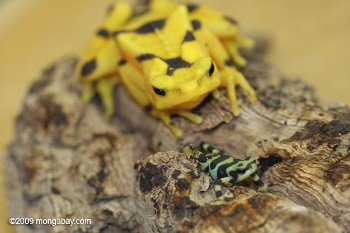 The Panamanian golden frog (pictured here with green infant) is one of a number of frog species to have gone extinct. Fortunately for this species, a population does survive in a number of zoos, but other frog species have not been so lucky. Photo by: Rhett A. Butler. |
Over 120 species have likely vanished in the past thirty years alone.
World’s first protests for frogs
One of the biggest events for Save the Frogs Day are peaceful protests against Uncle Julio’s Rio Grande restaurants in Virginia, Texas, and Maryland for its participation in the frog-legs trade.
According to SAVE THE FROGS!, the frog-legs trade removes an estimated 100 million frogs every year from the wild, raises the chances of spreading invasive species, and helps spread the highly-contagious chytridiomycosis, which is decimating frog populations globally.
“I think the frog legs protests are really cool,” Kriger told mongabay.com. “They demonstrate that the SAVE THE FROGS! movement has grown and that our supporters are prepared to take action. We aren’t going to wait around for new government regulations or for businesses to voluntary police themselves,”
The organization has already had success in working with restaurants to end the frog-legs trade. They will officially announce on Friday that due to awareness-raising from SAVE THE FROGS, San Francisco’s Restaurant Gary Danko will no longer be serving wild-caught Florida Pig Frogs (Rana grylio).
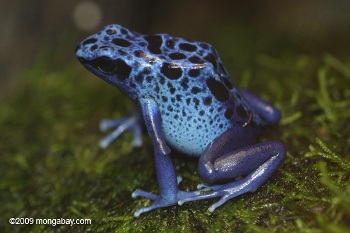 The blue arrow poison frog. Photo by: Rhett A. Butler. |
“They recently agreed to remove the frog legs from their menu and not to re-order them. Restaurant Gary Danko is the first restaurant in the world to remove frog legs from its menus for environmental reasons, and we expect many restaurants to follow in their footsteps,” says Kriger.
The day will also be the start of a new campaign for SAVE THE FROGS! and environmental partners to ban the herbicide Atrazine.
Long seen as detrimental to amphibians and other wildlife, a recent study showed that Atrazine changed male frogs into females through chemical castration, which the researchers said likely plays a big, but unseen, role in the current amphibian crisis. There are even concerns about the herbicide impacting human health. While, the EU banned Atrazine in 2004, the herbicide is still widely-used in the US and across the world.
Celebrations and education: frog-style
Save the Frogs Day is also about celebrating the world’s amphibians. In that light, organizers in Toronto have set up the First Annual Frog-Leap-a-Thon.
“This fundraiser event will be the largest gathering of Frog Leapers in recorded history, and is certain to catch the attention of many of Toronto’s inhabitants,” explains Kriger.
In several cities around the US people will have a chance to take walks with researchers to learn about frogs and hopefully run into some of the tiny creatures themselves.
“Getting people outside is one of the best ways to get them to care for and protect the environment,” says Kriger.
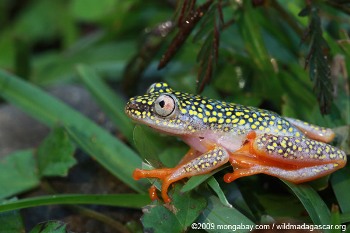 The white spotted reed frog from Madagascar. Photo by: Rhett A. Butler. |
Across the pond, so to speak, Ireland is hosting its first Save the Frog event at the Lough Boora parklands in county Offaly; the event will include a lecture and a hike.
SAVE THE FROGS! has also partnered with a number of organizations to spread the word and set up special events.
“Ranger Rick and the National Wildlife Federation are helping promote Save The Frogs Day,” says Kriger, “the Miss Earth South Africa ladies will be teaching South Africa’s kids about frogs; and we have large museums getting involved as well: the Chicago Academy of Science’s Peggy Notebaert Nature Museum and the World Museum in Liverpool.”
Kriger, himself, has a busy schedule set for Friday.
“I will be giving a Save The Frogs Day webinar that is open to anyone in the world who wants to log on and listen. This will be the first of many SAVE THE FROGS! Webinars on a variety of topics,” Kriger says. “I’m used to talking to a room full of people. Now I can talk to people around the world. For the environmental movement to be successful, we have to use communications technologies to our advantage, so I am always excited when SAVE THE FROGS! finds a new platform on which to communicate with people.” Free and open to the public the webinar will take place at 2:30 PST.
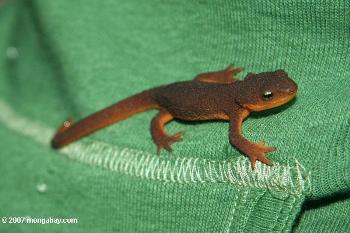 It’s not just frogs that are declining worldwide. Other amphibians, like salamanders and newts, are also in danger. This is a rough skinned newt from California. Photo by: Rhett A. Butler. |
Kriger will also be joining Mike Rotkin, the mayor of Santa Cruz, in visiting elementary students to talk about frogs. He will speak on the “Making a Living with Maggie” show on Martha Stewart Living Radio, which will air nationwide on Sirius 112/XM 157 at 1:30 PST. In the evening, Kriger will speak at the Elkhorn Slough National Estuarine Research Reserve in Watsonville, CA; this event will also include a sunset hike to find frogs.
Though Save the Frogs Day is only a couple days away, Kriger says there is always room for people to start new events: “Save The Frogs Day 2010 is a de-centralized event: that means it’s up to you to make something happen in your part of the universe. The frogs are depending on you. Your children and their children are depending on you.”
When asked why frogs matter, Kriger says: “I could tell you that frogs are bioindicators; that they eat ticks, mosquitoes and flies that spread diseases and damage our crops; that a large number of our pharmaceuticals are derived from frogs; that frogs provide innumerable ecosystem services to humans. All that is true, but those are all selfish reasons.”
The real reason?
“Frogs are an integral part of our existence on the planet, and they have as much right to inhabit the Earth as we do,” Kriger concludes.
For a list of events on Save the Frogs Day: http://www.savethefrogs.com/day/index.html
Information for teachers: http://www.savethefrogs.com/teachers/index.html
Information for students: http://www.savethefrogs.com/students/index.html
How to help frogs: http://www.savethefrogs.com/how-to-help/index.html
![]()
2nd Annual Save the Frogs Day image.

Save the Frogs Day banner for the Dallas Airport.
Related articles
The story of ‘Save the Frogs Day’, April 28th, An Interview with Kerry Kriger
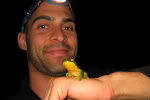
(04/26/2009) Founder and director of SAVE THE FROGS!, Dr. Kerry Kriger is responsible for the first annual Save The Frogs Day on Tuesday, April 28th with events planned worldwide from the United States to Nepal, and Australia to China. “I’m continually amazed at the positive response it’s gotten. I thought of Save The Frogs Day one night last December when I was the only full-time SAVE THE FROGS! employee and I only had a couple part-time volunteers,” Kriger explains.
Photos: Madagascar’s wonderful and wild frogs, an interview with Sahonagasy
(03/03/2010) To save Madagascar’s embattled and beautiful amphibians, scientists are turning to the web. A new site built by herpetologists, Sahonagasy, is dedicated to gathering and providing information about Madagascar’s unique amphibians in a bid to save them from the growing threat of extinction. “The past 20 years have seen resources wasted because of a poor coordination of efforts,” explains Miguel Vences, herpetologist and professor at the Technical University of Braunschweig. “Many surveys and reports have been produced that were never published, many tourists found and photographed amphibians but these photos were not made available to mapping projects, many studies carried out by Malagasy students did not make use of literature because it was not available.”
Common pesticide changes male frogs into females, likely devastating populations
(03/01/2010) One of the world’s most popular pesticides, atrazine, chemically castrates male frogs and in some instances changes them into completely functionally females, according to a new study in the Proceedings of the National Academy of Sciences. The authors conclude that atrazine likely plays a large, but unsuspected role in the current global amphibian crisis.
Bronx Zoo puts ‘extinct’ frogs on display
(02/02/2010) The Bronx Zoo has a put a most unusual frog on display: the Kihansi spray toad. For one thing, the Kihansi spray toad survived on only 5 acres in the Kihansi gorge in Tanzania, adapted to the areas’ unique and constant mist from the gorge and a waterfall. For another, female Kihansi spray toads give birth to live young, instead of laying eggs. Finally, the Kihansi spray toad is extinct—at least in the wild.
Photos: New tropical frog undergoes remarkable transformation
(02/01/2010) Nature never runs out of surprises. Exploring Sudest Island off of Papua New Guinea, researchers discovered a new species of frog that drastically changes its appearance from juvenile to adulthood, a transformation that has never been seen in another frog.The new species, named Oreophryne ezra, is shiny black with bright yellow spots. Yet when it matures, the frog becomes rose-colored and even its eyes change from black to blue.
Gone: a look at extinction over the past decade
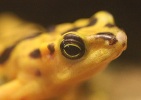
(01/03/2010) No one can say with any certainty how many species went extinct from 2000-2009. Because no one knows if the world’s species number 3 million or 30 million, it is impossible to guess how many known species—let alone unknown—may have vanished recently. Species in tropical forests and the world’s oceans are notoriously under-surveyed leaving gaping holes where species can vanish taking all of their secrets—even knowledge of their existence—with them.
Scientists uncover mystery of how frog plague kills its victims
(10/22/2009) One hundred and twenty species of frogs are reported to have gone extinct since 1980 (although the number is likely even higher). While devastated by habitat loss, pollution, and climate change, a baffling disease may be the biggest factor behind the alarming extinctions of frogs. Called chytridiomycosis, the disease is caused by the microscopic fungus Batrachochytrium dendrobatidis which kills its tiny victims indiscriminately.
South Korea’s frogs have avoided amphibian crisis so far, an interview with Pierre Fidenci

(09/09/2009) Frogs are on the edge. Blasted by habitat loss, pollution, and a terrible disease, the chytrid fungus, species are vanishing worldwide and those that remain are clinging to existence, rather than thriving. However, an interview with Pierre Fidenci, President of Endangered Species International (ESI), proves that there are still areas of the world where amphibians remain in abundance. South Korea is not a country that is talked about frequently in conservation circles. Other nations in the region attract far more attention, such as Malaysia and Indonesia. But it was just this neglect that drove Pierre Fidenci to visit the nation and survey the amphibians there.
Save the frogs, save ourselves

(09/04/2009) Amphibians are going extinct around the globe. As a scientist specializing in frogs, I have watched dozens of species of these creatures die out. The extinction of frogs and salamanders might seem unimportant, but the reality couldn’t be farther from the truth. Indeed, from regulating their local ecosystems, to consuming and controlling the population of mosquitoes and other insects that spread disease, to potentially pointing the way to new drugs for fighting diseases such as cancer or HIV-AIDS, the fate of these creatures is inexorably linked to our own.
Pesticide use linked to dying frogs in California
(08/13/2009) Pesticides used by farmers in California’s Central Valley could be killing frogs in the Sierra mountains, report researchers.
Approximately 200 new frogs discovered in Madagascar threatened by political instability

(05/11/2009) Amid the amphibian extinction crisis—where amphibians worldwide are disappearing due to habitat loss, pollution, and a devastating fungal epidemic—the Spanish Scientific Research Council (CSIC) has announced some good news. In a survey of the island-nation of Madagascar they have identified between 129 and 221 new species of frogs. The discovery of so many new species nearly doubles the island’s total number of frogs.

